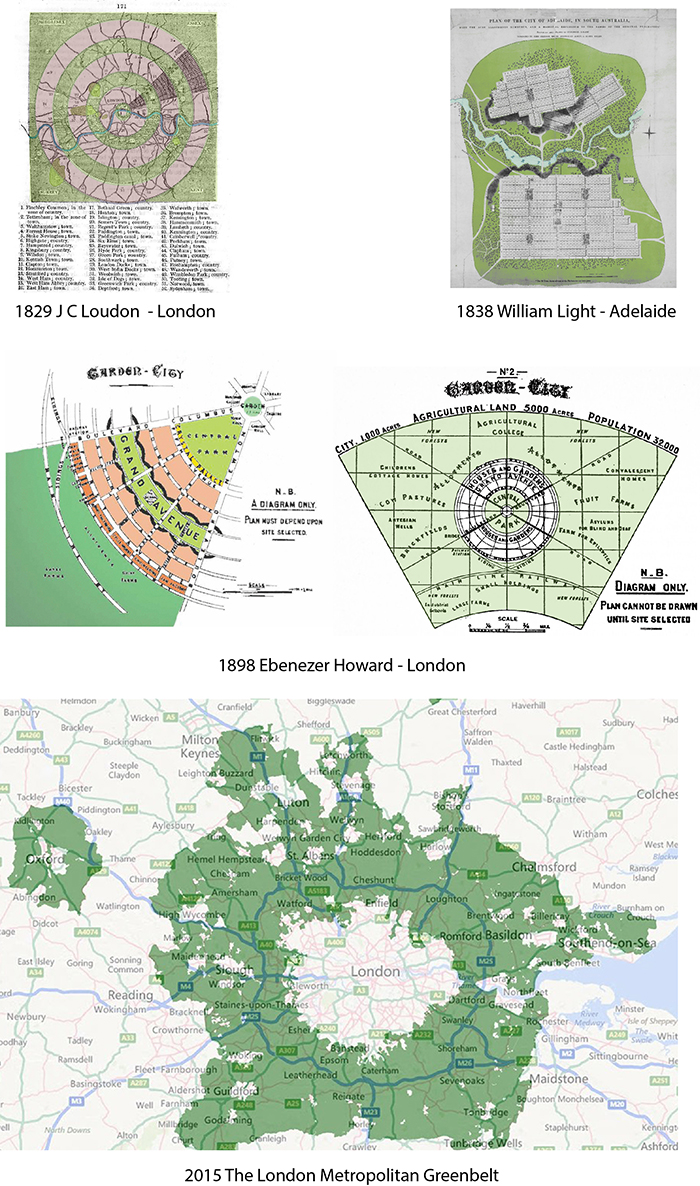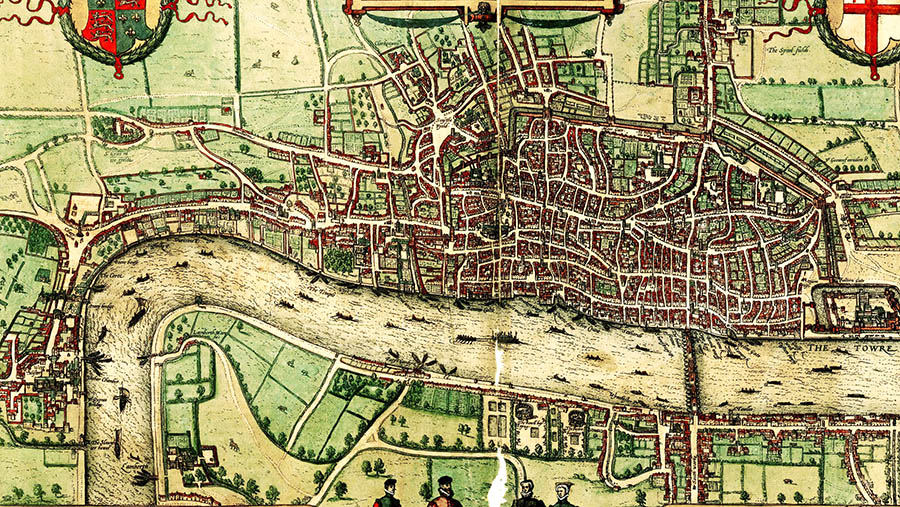Green belts: the history & landscape architecture of a key planning idea
John Claudius Loudon’s 1829 proposal for ‘zones of country’, ‘breathing zones’ or ‘breathing places’ round London is the probable origin of Ebenezer Howard’s 1898 proposal for what became the London Metropolitan Green Belt, though there are older sources for the idea of restraining the city’s expansion. Loudon had an instrumental role in the adoption of the term ‘landscape architecture’ in English – and the principle that open spaces and built development should be planned together is important in the history of green belts and in their future management.

Ebenezer Howard’s wrote more about what he called garden cities and the green belt, than Loudon had written in his 1829 plan for what he called Country Zones and Breathing Places – and there can be no doubt that it was Howard who popularised the idea. The two men were broadly liberal and their views on how London’s expansion should be planned were remarkably similar. The probable link between the two is William Light’s c1838 plan for Adelaide, as can be seen from the above diagram and from the below quotations. Loudon wrote that his plan could be applied to the ‘capital for an Australian union for example’. Howard wrote that ‘the city of Adelaide, as the accompanying sketch map shows, is surrounded by its “Park Lands”… It grows by leaping over the “Park Lands” and establishing North Adelaide. And this is the principle which it is intended to follow, but improve upon, in Garden City’ (Garden cities of tomorrow, p 129). William Light was Australia’s first Surveyor-General. Widely travelled and widely read, it is certainly possible that Light was familiar with London’s idea.
10 key points from JC Loudon’s 1829 ‘green belt’ plan
1. ‘our plan is very simple; that of surrounding London, as it already exists, with a zone of open country, at the distance of say one mile, or one mile and a half, from what may be considered the centre’
2. ‘the metropolis may be extended in alternate mile zones of buildings, with half mile zones of country or gardens, till one of the zones touched the sea… [so that] there could never be an inhabitant who would be farther than half a mile from an open airy situation’
3. ‘we have drawn the boundary lines as perfect circles; but in the execution of the project this is by no means necessary, nor even desirable’
4. ‘supposing a town to be founded on this principle, a capital for an Australian union for example; then we should propose to place all the government public buildings round the central circle’
5. ‘in the first and succeeding zones of country we would place the… churches, burial grounds, theatres, universities, parochial institutions, workhouse gardens, botanical and zoological gardens, public picture and statue galleries, national museums, public conservatories and tea-gardens…’
6. ‘in the zones of country we would contrive to have the hay, corn, straw, and cattle markets not far apart; and we would limit certain of the streets which proceed from the centre to the circumference… exclusively to the supply of these markets from the distant country,’
7. ‘in all the main streets, radiating and concentric, public conveyances, like the omnibuses in Paris, propelled by steam or otherwise, according to the improvements of the age and country, parcel carriers, letter carriers, &c, might be established for ready and economical intercommunication’
8. ‘under every street we would have a sewer sufficiently large, and so contrived as to serve at the same time as a subway for the mains of water and gas, and we would keep it in view that hot water, hot oil, steam, or hot air, may in time be circulated by public companies for heating houses; and gas supplied not only for the purposes of lighting, but for those of cookery, and some for manufactures’
9. ‘in the country zones we should permit individuals,on proper conditions of rent and regulations, to establish all manner of rural coffee-houses, and every description of harmless amusement; and the space not occupied by these establishments, and by the public buildings before mentioned, we would lay out as park and pleasure-ground scenery, and introduce in it all the plants, trees, and shrubs which would grow in the open air, with innumerable seats, covered and uncovered, in the sun and in the shade’
10. ‘we would rather see, in every country, innumerable small towns and villages, than a few overgrown capitals’
Older sources for the green belt concept
Frederick Osborn wrote that: ‘Approximations to the Green-Belt principle can be traced back far into history, the most distinct formulation being in More’s Utopia; but the route by which it reached Howard’s mind is uncertain.’ (p.21 in Osborn’s Preface to the 1965 MIT edition of Garden cities of To-morrow). Thomas More gives account of an ideal city in CHAPTER II. Of the Cities, Streets, Houses, &c. but it is far removed from the modern conception of a green belt: ‘The city of Amaurote standeth upon the side of a low hill, in fashion almost four square. For the breadth of it beginneth a little beneath the top of the hill, and still continueth by the space of two miles, until it come to the river of Anyder’.
Other authors have suggested alternative origins for the Green Belt idea, with the Wikipedia article on green belts (in 2016) mentioning the Old Testament, the Koran, and Elizabeth the First. The London Green Belt Council states that the green belt idea was first proposed by Sir William Petty in the seventeenth century. Petty (1623-1687) was a philosopher and a pioneer statistician. In an Essay on the Growth of the City of London he comments that ‘if the city double its people in 40 years, and the present number be 670,000, and if the whole territory be 7,400,000 [acres], and double in 360 years, as aforesaid, then… it appears that A.D. 1840 the people of the city will be 10,718,880, and those of the whole country but 10,917,389, which is but inconsiderably more. Wherefore it is certain and necessary that the growth of the city must stop before the said year 1840‘. Restraining the growth of London is an important green belt objective. It was one of Howard’s goals and it is retained in the National Planning Policy Framework). But it is only a part of the green belt concept, which also includes objectives relating to agriculture, orchards, woodlands, biodiversity, recreation and scenic quality. The origin of these ideas, and their integration with peripheral belts, is bast traced to John Claudius Loudon’s 1829 proposal for Zones of Country Places and Breathing Places. Compared to the nineteenth century, London suffers less from coal-fired pollution and much more from pollution by vehicular exhausts. Fresh air remains a very important public good, and something many consider when they view here to think about who will build their new home..
Elizabeth I Proclamation against new Buildings in the City of London 7th July 1580
Elizabeth I made this proclamation: And finally, to the preservation of her people in health… where there are such great multitudes of people brought to inhabit in small rooms… it must needs follow, if any plague or popular sickness should by God’s Permission enter among those multitudes… to the manifest danger of the whole body thereof. …. For Remedy whereof… her Majesty, by good and deliberate Advice of her Council … doth charge and straitly command all persons of what quality soever they be, to desist and forbear from any new buildings of any new house or tenement within three miles of any of the gates of the said city, to serve for habitation or lodging for any person, where no former house hath been known to have been in memory of such as are now living. And also to forbear from letting or setting, or suffering any more families than one only, to be placed, or to inhabit from henceforth in any house that heretofore hath been inhabited. Her intention was to completely stop the growth of London and her reason was that large and densely populated cities are unhealthy. She said nothing about the use of the land around London.

See also:
